Back again with something that, well... I am not quite sure WHERE it fits on a ukulele site. This is the Ibanez EWP14WB Piccolo.
This was originally something of a continuation of me featuring some small guitars that serve as crossover instruments for uke players who are 'curious', but that wouldn't be full reviews and would feature midweek. But I decided to give this a fuller written review too and sits alongside the ukuleles for reasons that will become clear.
And that is because this is kind of a guitar / ukulele hybrid. Usually when you see guitar uke hybrids we are talking about nylon strung 'Guitaleles' - which are essentially ukes with a couple of extra bass strings tuned in the same register as standard ukulele. I've reviewed one or two before but will say they are not my thing on account of the almost classical guitar style neck widths. This one harks back to quite an old instrument that is similar in many ways, but instead of the nylon strings (classical guitar style), it opts for steel strings, a more folk guitar feel and a shorter scale. They've called it a 'Piccolo Guitar' and like many Guitaleles, is tuned A to A (ADGCEA) so standard uke register. And that comes with a benefit, for my hands at least when you see the dimensions. Guitaleles have featured on the uke reviews and I consider this to be a guitalele with steel strings!
This is small bodied instrument with a modern double bout and Florentine cutaway which is immediately attractive. This is made from all laminate ovangkol wood in the body which is stripy and interesting to look at. Aside from that what surprised me here was how small the body was. In fact it's tenor uke sized. In fact the whole thing is very small and I think I need to just break from the review here to say a word about size.
When I see ukulele players who are reluctant to try guitars (or have tried and struggled) they seem to cite three main causes for concern. The extra two strings, the length of the neck and the width of the neck. This is a six string and I can't say more about that (though I do know many uke players who like guitalele, so six can't be all bad). The scale length here though is very odd for a six string as it's only 17 inches. That's tenor ukulele scale, never mind baritone, and compared to a dreadnought acoustic guitar you would be looking at more like 24.75 inches on one of those! Nut width too is surprising at 42mm. Whilst that is wider than a four string ukulele (to fit the extra strings in), it's far narrower than most guitaleles I see which need something like 48mm on account of the nylon strings (the reason I don't care for them, personally). So here we have a body that's small, a neck that is no longer than a tenor uke and a nut width that, whilst wider, is far more 'uke like' than a guitalele. Odd indeed!
Lets move on. The bridge here is made of purpleheart and uses a regular folk guitar pin arrangement to seat the ball end steel strings into the bridge. Ibanez list the saddle as being made from 'Ibanez Advantage' of which I have NO idea. It's some sort of composite. The whole thing is very tidy though. Spacing here is about 47mm.
Lets move on. The bridge here is made of purpleheart and uses a regular folk guitar pin arrangement to seat the ball end steel strings into the bridge. Ibanez list the saddle as being made from 'Ibanez Advantage' of which I have NO idea. It's some sort of composite. The whole thing is very tidy though. Spacing here is about 47mm.
Decoration here consists of dark edge binding to the top and back with extra black and white purfling around the top. Around the sound hole is more purfling coupled with an abalone ring which is not too ostentatious. The finish, is an open pore satin that shows off the wood colour nicely without being too glitzy or being a fingerprint magnet. I think the looks are great actually.
Inside is pretty tidy with regular back bracing and notched linings much like a ukulele. The top is much more heavily X braced though which will be on account of the extra tension from steel strings. This is why you really should never put steel strings on a regular ukulele!
The neck is made from okoume in three pieces jointed in the usual places. It tapers down to that 'narrow for a six string' 42mm nut which I really do think will have uke players interested. It's also not too rounded in the profile either. The neck is also fitted with an adjustable truss rod which has MUCH more relevance here than they do on a ukulele as they can be adjusted to set the right relief to counter string tension (slight concave bow in the neck).
That is topped with more purpleheart for the fingerboard which is also radiused (15.7 inch) for comfort. It's in good condition and edge bound to hide the fret ends of which we have 19 joined at the 14th. Pale wood position dots face out at the 3rd, 5th, 7th, 9th (guitar style!), double 12th, 15th and 17th. I think they look too large for the small instrument, but thankfully these are repeated with dots on the side.
Beyond the composite nut is a skinny headstock which I like the look of generally but whilst it is faced with something, it's not matching the ovangkol of the body. The Ibanez logo is screen printed in a pale cream.
Tuners, naturally, are numbered six, with three each side. They are sealed chrome gears and look mighty chunky to me and not the best metal quality. One of them is mis-aligned too! They work ok though, but look agricultural.
It comes with nothing else bar a set of 10's steel guitar strings though some stores suggest you get a rudimentary gig bag (I didn't). And the price on the street for these seems to be about £160 which is not a huge cost for any instrument.
Let's have a play. First of all volume and sustain are very good. They were always going to be as the steel string power and tension is what makes all guitars beat ukuleles on both of those facets. This punches hard and loud, particularly played with a pick (more on that below). You will have no issue being heard unless you are in a room with dreadnought guitars I suppose.
The thing with steel strung instruments though is the smaller you go in the body the more shrill the sound is. A dreadnought guitar for example has much more 'beef' to the sound than a parlour guitar will as there is more top real estate to broaden out the range. And so it is here, because that tiny body (for guitar standards) really doesn't leave much. As such the tone is extremely bright and perhaps a bit overly strident or reedy. Of course it's tuned higher than a guitar so that comparison is perhaps unfair, but it's very much 'in your face'. Playing with a pick (my preferred style with steel strings) seems to over drive it too much, particularly played strummed in first position, with some overtones and echo clearly coming through. It's much better up the neck where things seem more balanced, but that won't help those playing cowboy chords. Picking the notes mellows it out much more and you can create some rather pretty clear patterns with it played that way.
Moving to playing with fingers, and things a LOT mellower and rather pretty, though the sound you get will depend it you are using your nails or fingertips of course. Playing that way with nails on steel strings is a love it or hate it thing which many people can't adjust to. What I did find, played either way though is despite my comments above about nut width and not caring too much for wider nylon guitalele necks, I actually struggled with the narrower nut on this one a bit too much. That is down to the size of my fingers of course, but do bear that in mind. I found myself running out of room, particularly up the neck.
My comments on tone may come across negative and I think that is a bit unfair too. I think it's too easy to compare this to a guitar or a ukulele and it's neither of those things. It's it's own instrument and I think that is the part I have taken a shine to. You see, a mandolin is very strident played on it's own too, but they tend to be played to accompany other instruments to add a different layer to the sound of a band mix. And I think THAT is where somebody could make great use out of something like this - to add frills, lead licks or just a different counter pattern over the top of a ukulele band outfit. For that I totally get it... I think...
My comments on tone may come across negative and I think that is a bit unfair too. I think it's too easy to compare this to a guitar or a ukulele and it's neither of those things. It's it's own instrument and I think that is the part I have taken a shine to. You see, a mandolin is very strident played on it's own too, but they tend to be played to accompany other instruments to add a different layer to the sound of a band mix. And I think THAT is where somebody could make great use out of something like this - to add frills, lead licks or just a different counter pattern over the top of a ukulele band outfit. For that I totally get it... I think...
So I have warmed to this, but it took me a while to work out who it is going to appeal to or even what it was for. As a solo instrument I suspect the sound is a little too in your face to work like a guitar does, but 'it is what it is', as I say, and I think a huge range of sounds have their place in any ensemble. Played in a uke group or band I can see this adding a new dimension to the overall tone that won't take over. I just couldn't see this as being my only instrument. It will certainly be of interest to guitar players wanting to get involved in a uke group though as it plays just like a guitar and you are automatically in the same register as standard uke tuning. And of course the ease of transition for a uke player is really down to getting to grips with two more strings and nothing more so it may suit the guitar curious too.
I've rather like this little oddity to be honest with you. Recommended if you are looking for a new tone, but be sure you know where you are going to put this in a mix.
SPECS ROUNDUP
Model: Ibanez EWP14WB Piccolo
Scale: Tenor uke scale
Body: Laminate Ovangkol
Bridge: Purpleheart pin bridge
Saddle: Composite
Spacing at saddle: 47mm
Finish: Open pore satin
Neck: Okoume
Fingerboard: Purpleheart, 15.7" radius
Fingerboard: Purpleheart, 15.7" radius
Frets: 19, joined at 14th
Nut: Composite
Nut width: 42mm, 37mm A to A
Tuners: Unbranded chrome sealed gears
Strings: Steel guitar strings (10's)
Strings: Steel guitar strings (10's)
Country of origin: China
Weight: 825g
Price: Circa £160
PROS
Great looks
Good overall build and finish
Good volume and sustain
Tone all of its own (but see below)
Reasonable price
Tone all of its own (but see below)
Reasonable price
CONS
Cheap tuners
You really need to know WHY you would want this sound
SCORES
Looks - 9 out of 10
Fit and finish - 8.5 out of 10
Sound - 7.5 out of 10
Value for money - 9 out of 10
OVERALL SCORE - 8.5 out of 10
VIDEO REVIEW
GOT A UKULELE IS NOT PAID BY BRANDS OR SHOPS - YOUR KIND DONATIONS ARE WHAT KEEP THE SITE GOING! THANKS FOR YOUR HELP!
SAY THANKS WITH A BEER!
BECOME A GOT A UKULELE PATREON
OR
THANKS!

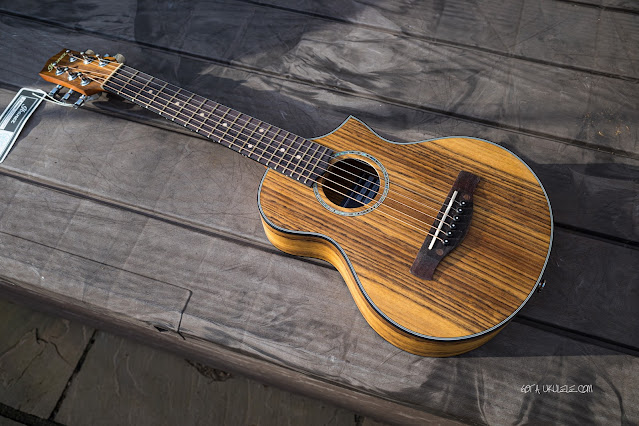
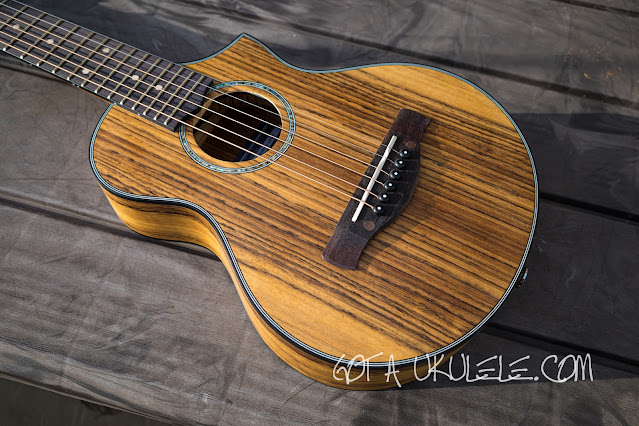


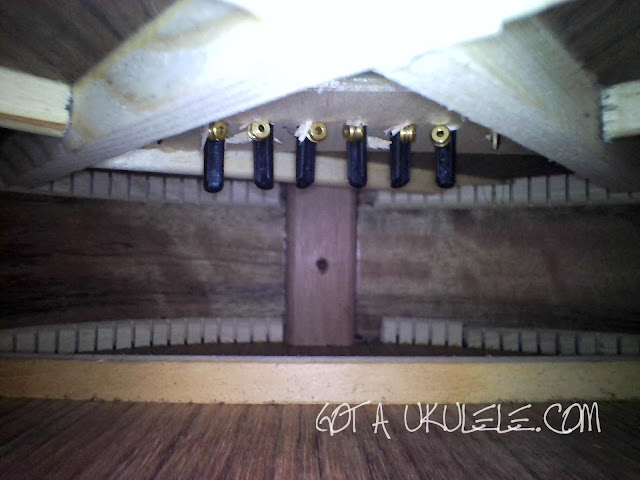


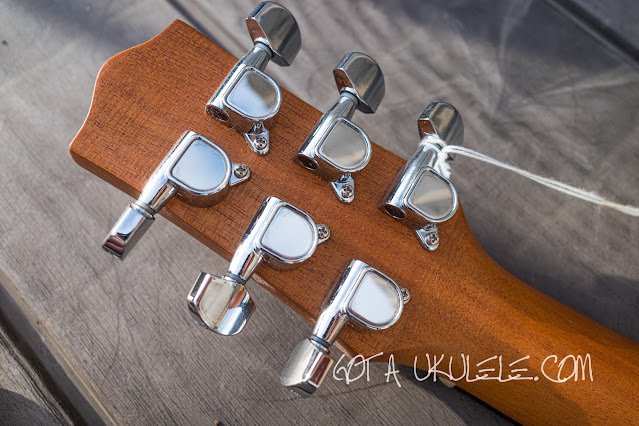
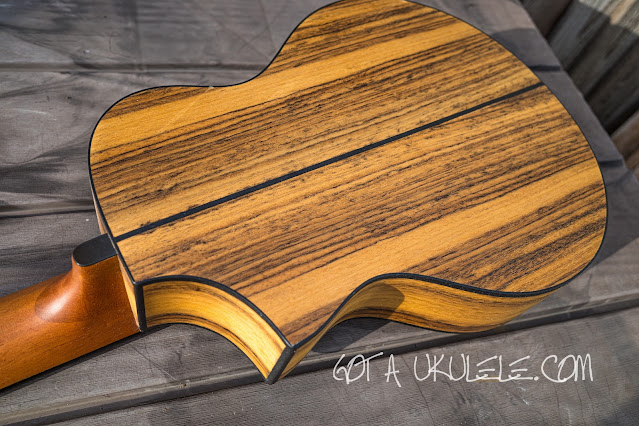

It sounds okay but very trebly because of short metal strings picked along a small scale. I feel that a tenor guilele with nylon strings, such as the one made by Yamaha, sounds richer, fuller and more pleasing especially as a solo instrument played without a pick. And a baritone-scale guilele is also an option.
ReplyDelete